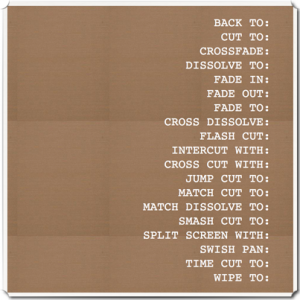Scene transitions

It is common practice in US-American scripts to specify distinctive, contrasting or special scene transitions in the script.
Momentum
Just like sentences are linked to create a fluent, dynamic and lively language scenes are also linked. The power of moving from scene to the next is called momentum. It triggers an impulse that leaps into the next scene and kick-starts it. These transitions may happen in an elegant, surprising, contrasting or associative way, e.g. through a kick, a match cut, a jump cut, a smash cut, through cross cutting, cliff-hangers or ellipses. By visualising the editing during the script development it is possible to cut down the scenes to the essentials and therewith ensure vibrant scenes.
Ellipse
With an ellipse the audience has to make the connection to the next scene.
Its purpose is to create dynamism because it’s not about translating every plot element of the story into a scene, on the contrary: everything the audience can figure out themselves, i.e. everything unspecific and everyday can be left out.
By using ellipses scenes are shortened or even cut. Unlike the macrostructure the scene doesn’t have to have a full dramatic arc; it follows the principle: get in as late as possible and get out as quickly as you can. When a scene is trimmed through the use of an ellipse the exposition is usually omitted. The scene starts in medias res and finishes directly after the crucial point. A scene that doesn’t have a dramatic function may as well be completely cut.
A favourite ellipse is to end a scene with a question that is then answered at the beginning of the next scene.
Kick
The kick is the final item in a scene and therewith part of the momentum. Metaphorically speaking it is the outstretched arm to the next scene. Depending on the narrative tone it may be a comic punch-line or a negative beat.
Cliff-hanger
The cliff-hanger is used to stretch the danger-expectation-moment. It shows the character in a severe dilemma and then delays the resolution by jumping to another scene or a different storyline. A cliff-hanger is especially useful at the end of a film with a planned sequel, at the end of a series’ episode or just before a commercial break. It is supposed to keep the audience’s interest because they’re eager to know the resolution.
Match Cut
The match cut suggests a similarity, overlapping or continuity between two image- or audio-elements, that don’t actually exist. It uses the continuity editing technique to create a seemingly seamless transition. This deception is usually already resolved in the next cut. The effect is a comic or meaningful association.
Jump Cut
Cuts with (almost) identical field sizes and angles are called jump cuts. A jump cut usually cuts an ellipse into a continuous movement and therewith creates a noticeable and irritating motion leap. It stands in contrast to a regular fluent smooth cut / continuity cut which are aligned to movement and light continuity and are not consciously perceived by the audience. The jump cut is used as a scene transition to communicate a leap in time at the same location.
Smash Cut
The smash cut leads to an abrupt breakup of a scene usually at its climax. It creates the biggest possible contrast to the subsequent scene: going from threatening to harmonic, from euphoric to depressed, from complete darkness to dazzling lightness or from noisy-loud to quiet. It is not unusual to get a comic contrasting effect.
Cross Cut
Cross cuts are the cuts between alternating storylines of a parallel montage.
Intercut
An intercut of a scene is, for example, a telephone conversation.


[…] Scene Transitions […]